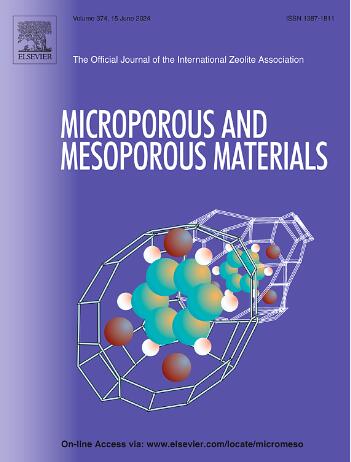Microwave synthesis of UiO-66 with encapsulated caffeine: Liquor mother reuse and release from polyamide composites
IF 4.8
3区 材料科学
Q1 CHEMISTRY, APPLIED
引用次数: 0
Abstract
In this study, UiO-66 was in-situ synthesized with encapsulated caffeine (CAF@UiO-66) following a one-pot DMF-free microwave-assisted method. The microwave-assisted approach allowed for an efficient and fast encapsulation of caffeine within the metal-organic framework in a single step thus achieving a more environmentally friendly process. It was shown that the CAF@UiO-66 solid was capable of gradually dosing caffeine into aqueous media over a long period. Moreover, the recovered synthesis solution containing residual caffeine and solvent was successfully reused in several encapsulation cycles, giving capsules that showed good caffeine release properties. In addition, CAF@UiO-66 solids were incorporated into polyamide 6 (PA6) fibers through an extrusion process without altering their physicochemical properties. These composites showed a gradual and sustained release of caffeine, extending the dosage time and shelf life of the additive which made it potentially useful for its application in functional textile products. Finally, the release of caffeine from the capsules was fitted to a Fickian model while that from the polymeric composites was adjusted to the semi-empirical Korsmeyer-Peppas model.

求助全文
约1分钟内获得全文
求助全文
来源期刊

Microporous and Mesoporous Materials
化学-材料科学:综合
CiteScore
10.70
自引率
5.80%
发文量
649
审稿时长
26 days
期刊介绍:
Microporous and Mesoporous Materials covers novel and significant aspects of porous solids classified as either microporous (pore size up to 2 nm) or mesoporous (pore size 2 to 50 nm). The porosity should have a specific impact on the material properties or application. Typical examples are zeolites and zeolite-like materials, pillared materials, clathrasils and clathrates, carbon molecular sieves, ordered mesoporous materials, organic/inorganic porous hybrid materials, or porous metal oxides. Both natural and synthetic porous materials are within the scope of the journal.
Topics which are particularly of interest include:
All aspects of natural microporous and mesoporous solids
The synthesis of crystalline or amorphous porous materials
The physico-chemical characterization of microporous and mesoporous solids, especially spectroscopic and microscopic
The modification of microporous and mesoporous solids, for example by ion exchange or solid-state reactions
All topics related to diffusion of mobile species in the pores of microporous and mesoporous materials
Adsorption (and other separation techniques) using microporous or mesoporous adsorbents
Catalysis by microporous and mesoporous materials
Host/guest interactions
Theoretical chemistry and modelling of host/guest interactions
All topics related to the application of microporous and mesoporous materials in industrial catalysis, separation technology, environmental protection, electrochemistry, membranes, sensors, optical devices, etc.
 求助内容:
求助内容: 应助结果提醒方式:
应助结果提醒方式:


